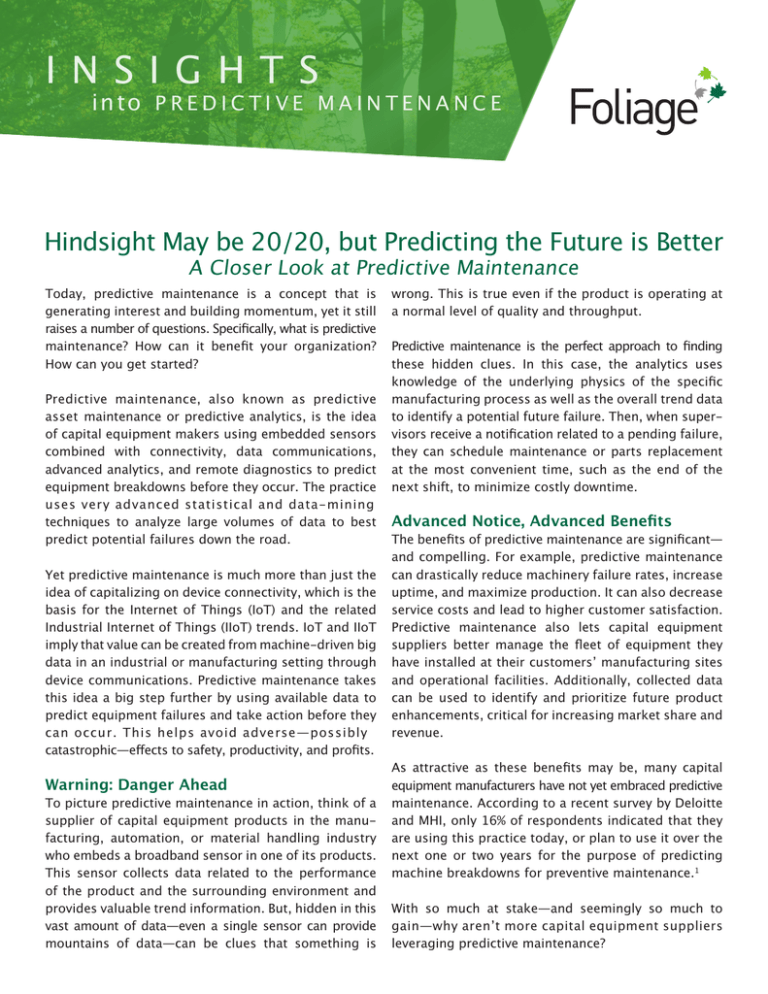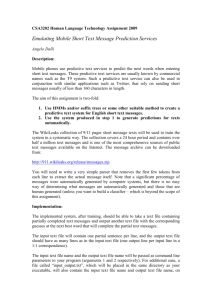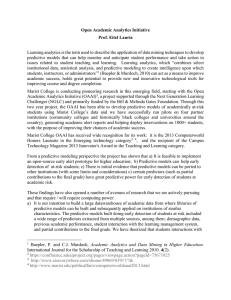I N S I G H T S into
advertisement

I N SI G H T S into P R E D I C T I V E M A I N T E N A N C E Hindsight May be 20/20, but Predicting the Future is Better A Closer Look at Predictive Maintenance Today, predictive maintenance is a concept that is generating interest and building momentum, yet it still raises a number of questions. Specifically, what is predictive maintenance? How can it benefit your organization? How can you get started? Predictive maintenance, also known as predictive asset maintenance or predictive analytics, is the idea of capital equipment makers using embedded sensors combined with connectivity, data communications, advanced analytics, and remote diagnostics to predict equipment breakdowns before they occur. The practice uses very advanced statistical and data-mining techniques to analyze large volumes of data to best predict potential failures down the road. Yet predictive maintenance is much more than just the idea of capitalizing on device connectivity, which is the basis for the Internet of Things (IoT) and the related Industrial Internet of Things (IIoT) trends. IoT and IIoT imply that value can be created from machine-driven big data in an industrial or manufacturing setting through device communications. Predictive maintenance takes this idea a big step further by using available data to predict equipment failures and take action before they can occur. This helps avoid adverse—possibly catastrophic—effects to safety, productivity, and profits. Warning: Danger Ahead To picture predictive maintenance in action, think of a supplier of capital equipment products in the manufacturing, automation, or material handling industry who embeds a broadband sensor in one of its products. This sensor collects data related to the performance of the product and the surrounding environment and provides valuable trend information. But, hidden in this vast amount of data—even a single sensor can provide mountains of data—can be clues that something is wrong. This is true even if the product is operating at a normal level of quality and throughput. Predictive maintenance is the perfect approach to finding these hidden clues. In this case, the analytics uses knowledge of the underlying physics of the specific manufacturing process as well as the overall trend data to identify a potential future failure. Then, when supervisors receive a notification related to a pending failure, they can schedule maintenance or parts replacement at the most convenient time, such as the end of the next shift, to minimize costly downtime. Advanced Notice, Advanced Benefits The benefits of predictive maintenance are significant— and compelling. For example, predictive maintenance can drastically reduce machinery failure rates, increase uptime, and maximize production. It can also decrease service costs and lead to higher customer satisfaction. Predictive maintenance also lets capital equipment suppliers better manage the fleet of equipment they have installed at their customers’ manufacturing sites and operational facilities. Additionally, collected data can be used to identify and prioritize future product enhancements, critical for increasing market share and revenue. As attractive as these benefits may be, many capital equipment manufacturers have not yet embraced predictive maintenance. According to a recent survey by Deloitte and MHI, only 16% of respondents indicated that they are using this practice today, or plan to use it over the next one or two years for the purpose of predicting machine breakdowns for preventive maintenance.1 With so much at stake—and seemingly so much to gain—why aren’t more capital equipment suppliers leveraging predictive maintenance? Making the Case It’s an interesting question, especially when capital equipment makers stand to gain a substantial competitive advantage with this type of innovation. As the value of the asset they are selling and the impact of that asset’s failure both increase, so too does the rationale for investing in predictive maintenance. Consider the case of jet engines, which are very expensive to build and have an extremely high impact in the case of failure. Manufacturers of jet engines are using predictive maintenance to minimize engine downtime caused by parts failure or to improve efficiency and performance. For example, GE uses sensors to collect jet engine data to perform short bursts of maintenance before larger issues can occur and create downtime. This means that over an entire lifecycle, the engine spends less time in repairs, which has led to significant productivity gains for GE employees.2 Market and industry factors are driving the return on investment of predictive maintenance down to less expensive products. Today, warehouses and manufacturing plants are becoming smaller, closer to consumers, and more automated to better respond to consumer demand for customized products. Yet as automation increases, the number of human workers decreases, a trend that requires even more automated decision-making, especially when those decisions are related to machine maintenance. Finally, recent advances in data tools, technologies, and services further enable the concept of predictive maintenance. The cost of extracting value from big data— once considered prohibitive—is decreasing every day. Increasingly powerful data tools and analysis techniques are now readily available, and are being deployed by sophisticated users familiar with advanced statistical methods as a means to create business insight. All of this is evidence that the time is right for capital equipment suppliers to develop predictive maintenance functionality that will result in increased market share and keep the competition at bay. Where Do We Go from Here? Yet the question remains: how do capital equipment makers proceed with predictive maintenance? Stay tuned for the next article in this two-part series, which will describe how companies can implement specific programs to make predictive maintenance a reality. Sources: 1 Deloitte and MHI, “The 2015 MHI Annual Industry Report: Supply Chain Innovation—Making the Impossible Possible,” p. 26, 2015. 2 Computing, “The Future Is Here Today: How GE Is Using the Internet of Things, Big Data and Robotics to Power its Business,” March 12, 2015. About the Author – Tom Mariano As Executive Vice President and General Manager, Tom provides strategic oversight and technical expertise to Foliage’s Industrial Equipment practice. He has over 25 years of experience in software development, engineering and marketing management. Tom’s focus during his career includes semiconductor and automotive manufacturing automation; robotics and material handling for warehouse and distribution solutions. He holds a Master of Science in Robotics and Control Systems from MIT, and a Bachelor of Science in Mechanical Engineering from Northeastern University. Have questions about predictive maintenance? Contact Tom at tmariano@foliage.com About Foliage Foliage, part of the Altran Group, is a global product development company partnering with clients to address the business and technical challenges inherent in developing, manufacturing and supporting complex, connected systems. Providing a full complement of technology consulting and engineering services, Foliage ensures clients deliver innovative solutions to market while reducing total cost of ownership over the lifecycle of their products. Visit foliage.com Foliage | 20 North Avenue, Burlington, MA 01803 | +1.781.993.5500 | foliage.com FIIMSAMH-16v0





